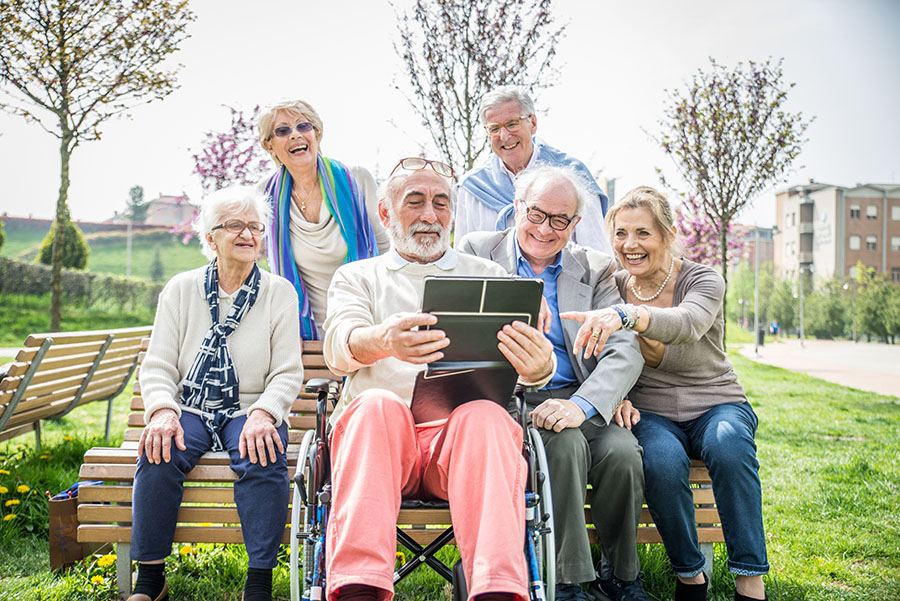How Social Media Can Help Advocate for PACE Participants
There are many tools in the palm of our hands that can support seniors in more ways than one, and some PACE organizations can use them to their advantage. Social media is not just for Gen Z but can be used by anyone seeking a sense of belonging and community. In addition to providing independent living solutions for seniors, PACE programs should consider establishing an online presence for their participants to expand their reach and allow them to bring a small piece of PACE home with them.
Why Seniors Benefit from Using Social Media
It’s a common misconception that seniors find social media too complex or disinterested in integrating technology into their daily lives. However, studies show that this is not the case, especially in the wake of COVID-19. In fact, 78% of older adults now use technology to connect with loved ones. More importantly, social media has become a powerful tool in combating loneliness among seniors, providing them with a platform to connect with others and engage in community activities.
97% of adults over 50 use their smartphones daily, revealing that older adults have begun to embrace smartphone technology. In the same study, four out of ten adults over 50 agree that tech enables a healthy life to help with anxiety and depression, breaking bad habits, and getting better sleep. Social media, in particular, has enabled seniors to participate in community activities because of the ease of finding like-minded people with whom to build relationships.
You might be thinking, how can PACE programs use social media to its advantage?
How Social Media Can Be Used to Advocate for PACE Programs and Participants
Social media can be a powerful tool for PACE advocacy. For instance, PACE organizations can use platforms like Facebook to share success stories, highlight the diverse experiences of their participants, and showcase the support programs provide. This can help change the narrative around aging and demonstrate the positive impact of PACE programs in its participants lives as well as assist in the recruitment of new participants to the program.
Social media can be used for the following reasons:
Raising Awareness
PACE is a life plan, enabling social integration and individualized medical treatment. Social media can be used to raise awareness and educate the general public regarding the benefits and diverse experiences of older adults. 71% of adults 50 and older use Facebook as their primary social media platform, so why not use it? PACE programs can use social media, like Facebook, to share success stories, share information, and push the actual narrative of what aging looks like in PACE programs.
Community Building
With any social media platform, the purpose is to connect with others. As PACE aims to sustain independence and provide individualized care for its participants, the best way to do this is to create online communities, keeping participants involved when at home. Using features like Facebook Live can start conversations and provide information in real-time while allowing participants and their families to share any concerns or ask questions they may have. Building an online community for your PACE organization can be used as an additional way to reduce social isolation and keep your participants updated with community activities and other essential information.
Educational Outreach
Social media can be an effective tool for educating seniors and their loved ones about the benefits offered and qualifications required by PACE programs. Organizations can share detailed information regarding PACE eligibility, coverage, services, community involvement, and more, making it easier for participants to understand what PACE offers. With so much information generated from a simple search, it is understandable that seniors get overwhelmed and reject technology as a proactive option. Social media becomes a one-stop-shop for participants to clearly understand the benefits PACE provides while working as a solution for organizations to share content they think accurately reflects its participants’ needs.
In an age of constantly evolving technology, it is helpful to research ways that different platforms can elevate your PACE program’s communication strategy. Social media can be used to advocate for PACE programs’ efforts to support seniors’ age in place while educating the public about what aging looks like today. By establishing a social media presence, PACE organizations can reach a wider audience, engage with their participants and their families, and create a supportive digital community. This can significantly improve their participants’ physical and mental health, combat loneliness, and enhance their overall quality of life.
At Momentm, we enable transportation for PACE organizations across the country, providing a NEMT software solution that will help build trust between participants and your PACE program offerings. Schedule a demo with one of our experienced staff today to see how we can build Momentm together.
